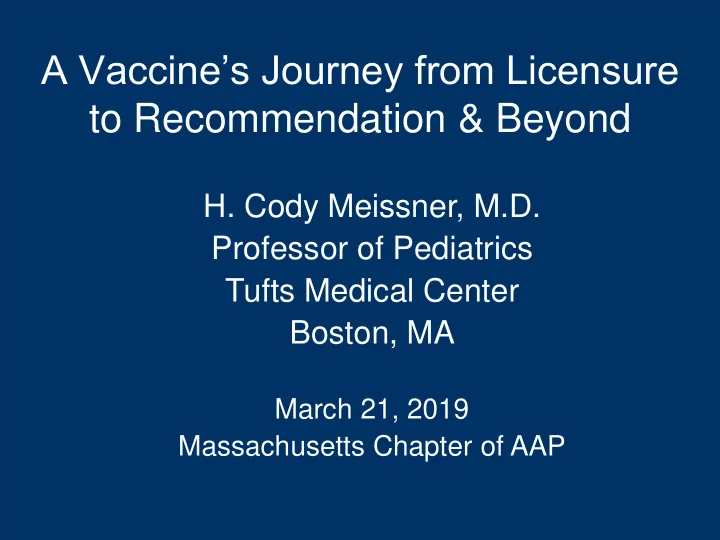

A Vaccine’s Journey from Licensure to Recommendation & Beyond H. Cody Meissner, M.D. Professor of Pediatrics Tufts Medical Center Boston, MA March 21, 2019 Massachusetts Chapter of AAP
Disclaimers/Disclosure • I have no financial relationship with the manufacturer(s) of any commercial product(s) discussed in this presentation • I may discuss the use of vaccines in a manner not consistent with the Package Insert, but all recommendations are in accordance with recommendations from the ACIP & AAP
Today’s Learning Objectives • Why we vaccinate – Individual protection – Understanding community protection (herd immunity) • How FDA evaluates a vaccine • How the CDC makes recommendations – Why there may be differences between the package insert and recommendations for vaccine use • How vaccine safety is monitored • Vaccine administration: from needle to micropatch
Licensed Vaccines in United States, 2019 Special settings Routine childhood use (11 diseases) (16 diseases) • • Diphtheria, tetanus, pertussis Adenovirus • • Haemophilus influenzae type b Anthrax • • Hepatitis A Bacille de Calmette-Guérin (BCG) • Hepatitis B • Cholera • Human papillomavirus • Japanese encephalitis virus • Influenza • Meningococcal B • Measles, mumps, rubella • Rabies • Meningococcal (ACWY) • Typhoid • Pneumococcal • Vaccinia (smallpox) • Poliomyelitis • Yellow fever • Rotavirus • Zoster (shingles) • Varicella
Epidemics in the 21 st Century 1. MERS coronavirus 2. SARS coronavirus 3. A/2009(H1N1)pdm influenza virus 4. Acute flaccid myelitis EV-D68 (?) 5. Ebola virus filovirus 6. Zika virus flavivirus
Other Vaccines in Development 1. C. difficile 2. Cytomegalovirus 3. Dengue 4. Hexavalent vaccine (Vaxelis) 5. Lyme 6. Norovirus 7. RSV 8. S. aureus 9. Streptococcus, group A 10. Streptococcus, group B 11. West Nile virus 12. Zoonotic influenza viruses
Mortality Rates per 100,000 Population in United States, 1900-2015 JAMA 316(20):2016
Vaccine Impact on Disease in U.S. 20 th Century 2016 Percent Estimated Reported Disease Decrease Annual Cases Cases Smallpox 29,005 0 100% Diphtheria 21,053 0 100% Polio (paralytic) 16,316 0 100% Measles 530,217 69 >99% Rubella 47,745 5 >99% Congenital Rubella Syndrome 152 1 >99% Haemophilus influenzae b 20,000 22 >99% Mumps 162,344 5,311 97% Tetanus 580 33 94% Pertussis 200,752 15,737 92%
Community Protection Blue = not immunized but still healthy Yellow = immunized but healthy Red = not immunized, sick and contagious
Community Protection Important for: 1. Children/infants too young to be vaccinated 2. Pregnant women 3. People in whom vaccinate induced immunity has waned 4. Immunosuppressed patients who cannot be vaccinated 5. Elderly who may not mount an adequate immune response to a vaccine 6. People with inadequate access to vaccinations 7. People who remain unvaccinated by choice
Development of Vaccine Recommendations • CBER = Center for Biologics Evaluation Vaccine Development & and Research Testing • VRBPAC = Vaccines and Related Biological Products Advisory Committee • ACIP= Advisory Committee for BLA Submitted to Immunization Practice FDA/CBER Advises FDA Licensure VRBPAC ACIP Advises CDC Recommendations (AAP, ACOG, AAFP )
The Vaccine Trials Paradigm • Phase 1 – Preliminary safety & immune response in small number of subjects • Phase 2 – Safety & immunogenicity in larger groups; target populations, selection of formulation, compatibility with concomitant vaccines • Phase 3 – Efficacy in large scale trials (randomized, controlled, double blind design when possible) – licensure • Phase 4 – Impact & safety post-licensure under real-life conditions, modifications in formulation and immunization schedule
Considerations Before a Vaccine is Licensed & Recommended • Safety • Compatibility with existing schedule • Efficacy • Simplification of the • Age when disease is most immunization schedule likely to occur • Minimization of the number • Effect of age on the of doses immune response • Cost-effectiveness • Duration of the immune response • Impact on community (herd) immunity • Need for booster doses • Vaccine acceptance by • Equity members of the public • Vaccine supply
Recommendations for IIV & LAIV, 2018-19 • ACIP (CDC) – For the 2018-19 season, providers may choose to administer any licensed, age-appropriate influenza vaccine (IIV, RIV4, or LAIV4). – LAIV4 is an option for those for whom it is otherwise appropriate, based on age and health. • COID (AAP) – For the 2018-19 season, AAP recommends IIV3/4 as the primary choice for all children because LAIV4 was inferior against A/H1N1 in past seasons and efficacy is unknown for the upcoming season – LAIV4 may be offered for children who would not otherwise receive an influenza vaccine
Vaccine Safety • Prelicensure – Clinical trials • Phases 1, 2, 3, 4 • Postlicensure – Vaccine Adverse Events Reporting System – Vaccine Safety Datalink (VSD) – Clinical Immunization Safety Assessment Network (CISA)
The Primary Objectives of VAERS • Detect new, unusual, or rare vaccine adverse events • Monitor increases in known adverse events • Identify potential patient risk factors for particular types of adverse events • Identify vaccine lots with increased numbers or types of reported adverse events • Assess the safety of newly licensed vaccines
VAERS: Reporting System Co-administered by CDC & FDA Limitations Strengths • Rapid signal detection • Reporting bias (e.g. underreporting, • Can detect rare adverse stimulated reporting) events • Inconsistent data quality • Generates hypothesis and completeness • Encourages reports from • Not designed to assess if providers and accepts vaccine caused an reports from patients and adverse event others • Lack of unvaccinated • Data available to public comparison group
Microneedle Patch
Microneedle Patch
The End
Recommend
More recommend